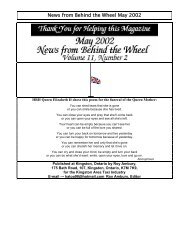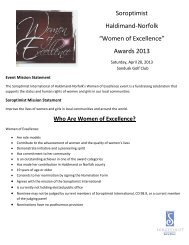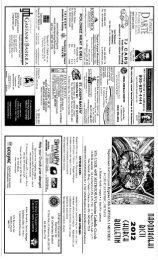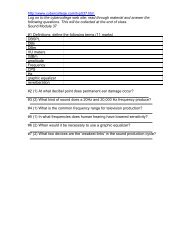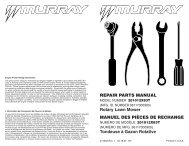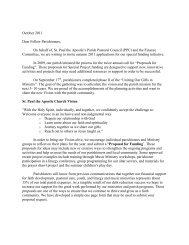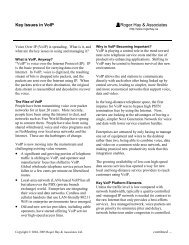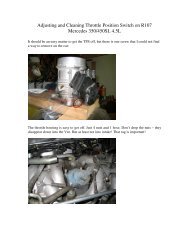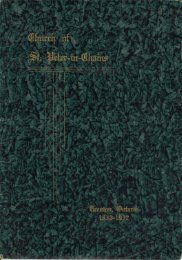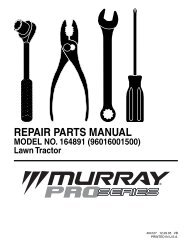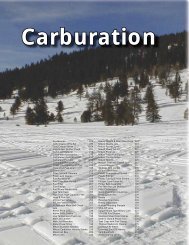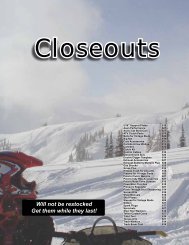You also want an ePaper? Increase the reach of your titles
YUMPU automatically turns print PDFs into web optimized ePapers that Google loves.
Wood Wonders<br />
By Pattti Post<br />
Published in the spring 2006 edition of the Sideroads Magazine, Georgetown Independent<br />
<strong>Joe</strong> <strong>Coutts</strong> can take an old loom and turn it into a raven caught in a gust of autumn<br />
leaves, or create a table base that is art-under-glass from hard<strong>wood</strong> planks.<br />
Working quietly in his Tweedle Street studio in Glen Williams, <strong>Coutts</strong> has a reputation for<br />
being “the best in the world at what he does,” according to fellow artist Terry Black, painter and<br />
film maker, whose own major works sell for $25,000, worldwide.<br />
“No one else does what (<strong>Coutts</strong>) does. He’s an artist of international stature,” says<br />
Black. “He’s not a <strong>wood</strong> carver. He’s a <strong>sculptor</strong>. His study of flight and motion with birds is totally<br />
unique. He has tremendous insight and perception; very strong ideas and creativity.”<br />
Carvers agree. Nine-time world champion wildfowl carver, Pat Godin, says, "the art work<br />
of <strong>Joe</strong> <strong>Coutts</strong> is refreshingly unique in a world where original thought is a rarity. <strong>Joe</strong> is among<br />
the few artists working in three-dimensions who have chosen to pursue a direction that is clearly<br />
identified with them and you really have to respect him for that.”<br />
The recognized uniqueness of <strong>Coutts</strong>’ art is due to skillful rendering of what he observes<br />
in nature and his use of exotic hard<strong>wood</strong>s rather than paint for colour.<br />
He works with several kinds of <strong>wood</strong>, depending on colour perspective: black walnut,<br />
West African babinga, hard maple, yellow pau ameralla, black African gaboon, cherry, and<br />
others.<br />
Wood sculpting is part engineering, part science, and all art for <strong>Coutts</strong>, who draws<br />
inspiration from his walks with the family dog around the Glen.<br />
“One day on 10 Sideroad, I saw five sandhill cranes flying towards me, and heard their<br />
unmistakably loud trumpet-like call. It’s very unusual for them to come to this area. But I think<br />
they’d gotten lost during a storm. They were circling, then eventually found their direction.”
It’s <strong>Coutts</strong>’ close study of natural drama that supplies creative material for his art. And<br />
those epiphanic moments, captured in his work, are what attract his clients.<br />
Tom Caldwell, Chairman of Caldwell Securities Ltd., Toronto, and Member of the Order<br />
of Canada, has two <strong>Coutts</strong> sculptures in his office. He says it’s the stories they tell, besides their<br />
beauty, that he values.<br />
What sold Caldwell on The Sharp-shinned Hawk, was its portrayal of relentless<br />
persistence.<br />
<strong>Coutts</strong> had witnessed this hawk – considered a low form of the species – fly smack into<br />
a tree trunk while pursuing a robin that had escaped through the branches. Even though the<br />
hawk was knocked out cold by the impact, he rallied and continued the hunt.<br />
“I liked the story of that determination and focus,” said Caldwell. “But I was also very<br />
impressed with the execution: highly detailed and beautiful pieces, individually crafted in natural<br />
<strong>wood</strong>, to bring out the colour of the bird. They are really quite remarkable works of art.”<br />
“The other piece we have – The Red-tailed Hawk and Crows - was purchased by my<br />
stepfather, Roy Pledger. Two crows are harassing a hawk, but the hawk has one of them by a<br />
tail feather, about to take a swipe at it, and you don’t know whether or not he’s going to get<br />
away. Will the hunted become the hunter?”<br />
“The other crow is swooping away, and it’s a nanosecond dynamic of aerial combat. <strong>My</strong><br />
stepfather was in the RAF and has been in the aircraft business his whole life. So it really spoke<br />
to his interest.”<br />
It’s a quality-of-life investment for Caldwell, rather than simply a financial or even<br />
aesthetic one.<br />
“It’s a good investment if I enjoy it, and if it speaks to me in a positive way. If I walk by<br />
that sharp-shinned hawk on a tough day, it’s a reminder of who I am and what I do. It’s uplifting.<br />
A form of therapy - of encouragement. It gives me positive reinforcement.”<br />
2
The beauty of birds in flight, and the striking metaphors <strong>Coutts</strong> creates, began during<br />
hikes taken along B.C.’s north shore more than 25 years ago.<br />
<strong>Coutts</strong> discovered a love for <strong>wood</strong> carving in the early 60s, when he decided to make,<br />
rather than buy, duck decoys. Then he became intriqued with mixing varieties of <strong>wood</strong> and grain<br />
to show colour and detail.<br />
During the mid-90’s, he started creating furniture art as well.<br />
Barbara Moore, a financial advisor with Wachovia in New York, says she and her<br />
husband, Jim, commissioned <strong>Coutts</strong> to create four glass-topped tables for their family room.<br />
The artist proposed the concept of each table representing a season; with irises, water<br />
weeds and incoming birds for spring, tiger lilies for summer, birds leaving and fallen leaves for<br />
fall, and snow-frosted bullrushes and dark leaves for winter.<br />
The Four Seasons Suite is designed to give the impression of walking along the bank of<br />
a stream. If the tables were circled, the carving would become the outside edge of a pond that is<br />
divided into quadrants.<br />
And that is the impression the Moores have achieved by placing the tables around the<br />
circular couch in their family room, overlooking Green<strong>wood</strong> Lake in New York.<br />
Moore says <strong>Coutts</strong>’ art work is museum quality.<br />
“They are the first thing people see when they walk into our house, and they are<br />
awestruck. The tables are spectacular.”<br />
“His work is expensive,” says Black, “but for what it is - it’s still a bargain, and people<br />
who buy his art, appreciate that.”<br />
<strong>Coutts</strong> takes pride in being able to create what he visualizes – something many artists<br />
strive for, but don’t always achieve<br />
3
“I’m satisfied with the finished product,” he says.<br />
But getting to that point is not easy. Notes and engineering drawings record the<br />
development of ideas, followed by construction of a maquette – a model of the intended work.<br />
Then the sculpting begins.<br />
Throughout this process, alterations are made and solutions are found to problems that<br />
can only be discovered as the piece takes shape. <strong>Coutts</strong> is constantly working to ensure correct<br />
balance, rendering and expression.<br />
Future plans include having some of his pieces cast in bronze – a process he is familiar<br />
with, having worked at Artcast in Georgetown. Casting will enable him to issue more than one<br />
piece at a time, as well as give the art work even greater longevity.<br />
But the shimmer and sensual texture of <strong>wood</strong> will also continue to be in demand.<br />
A current work in progress depicts a day lily, with sumptuous-looking yellow petals made<br />
of pau amarella, with darker shadings from orange babinga <strong>wood</strong>. The fine, black walnut frame<br />
below the flower belies the table’s base strength. Every detail is meticulously shaped, even the<br />
slender stamen of the flower. The 14-inch diameter of the lily is surrounded and supported by<br />
grass-like leaves also of black walnut.<br />
“Every piece is planned according to a definite series of steps,” says <strong>Coutts</strong>. It takes<br />
approximately six weeks to complete a project - making a pattern, setting it up and building it.<br />
In the corner of his shop, hangs the maquette of a large snowy owl in flight,<br />
commissioned by Imax Corporation founder, Robert Kerr, who has other bird sculptures by<br />
<strong>Coutts</strong>, and wanted something suited to hang in the exposed beams of his Muskoka home.<br />
often.”<br />
“I like the owl, because it’s graceful in flight, although it’s not something that’s seen very<br />
Kerr has a specially informed appreciation for <strong>Coutts</strong>’ mediium of <strong>wood</strong>. Now in<br />
retirement, he is building a <strong>wood</strong>en steam launch.<br />
4
“<strong>Joe</strong>’s creativity and ability with <strong>wood</strong> is quite wonderful.”<br />
The only sculpture <strong>Coutts</strong>’ has painted is the black raven currently in his studio. He<br />
decided against using African ebony because of its protected resource status.<br />
This piece has personal meaning for <strong>Coutts</strong>. It’s made of red oak from his late mother’s<br />
loom. Missing pieces made the equipment unusable, and he wanted to create something his<br />
family would value.<br />
During long hours of studio work, <strong>Coutts</strong> sometimes needs a voice of encouragement,<br />
even if it’s his own.<br />
On his worktable, is a small, black marker sign, ‘Keep It Going’<br />
He smiles and says, “I can stare at something and think about how it should be for a<br />
very long time. It’s important to take time to think ahead, but not so much that it gets in the way<br />
of progressing with the piece.”<br />
As delicate as the bird feathers and base flowers look, their strength is underpinned by<br />
steel rods that hold everything securely in balance. The top feathers of a wing, for example, are<br />
sculpted first, and under them, the rod is installed, bent to fit the wing shape. <strong>Joe</strong> then carves a<br />
bottom piece, and attaches it underneath the wing, covering the pin.<br />
But beyond all the necessary steps to make the piece work, aesthetically and practically,<br />
at some point, says the artist, he “has to let intuition take over.”<br />
“When you see one of his bird sculptures, you almost think that if you touched it, you<br />
would feel real feathers,” says local resident, Gail LaBranche.<br />
<strong>Joe</strong> <strong>Coutts</strong>’ website is at http://joecoutts-<strong>wood</strong><strong>sculptor</strong>.com/<br />
He also displays his art at two annual shows:<br />
Fine Furnishings Providence show in Rhode Island in the fall www.finefurnishingsshow.com;<br />
Philadelphia Furniture and Furnishings Show in the spring<br />
www.pffshow.com<br />
5



